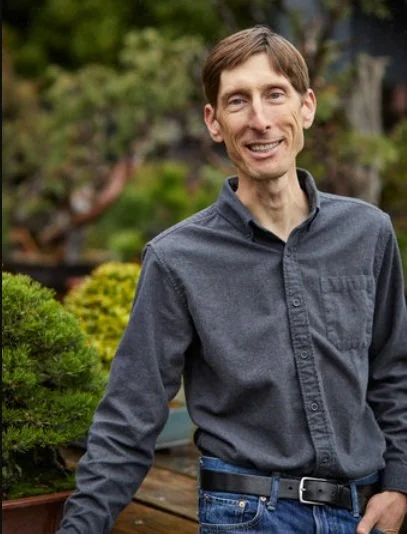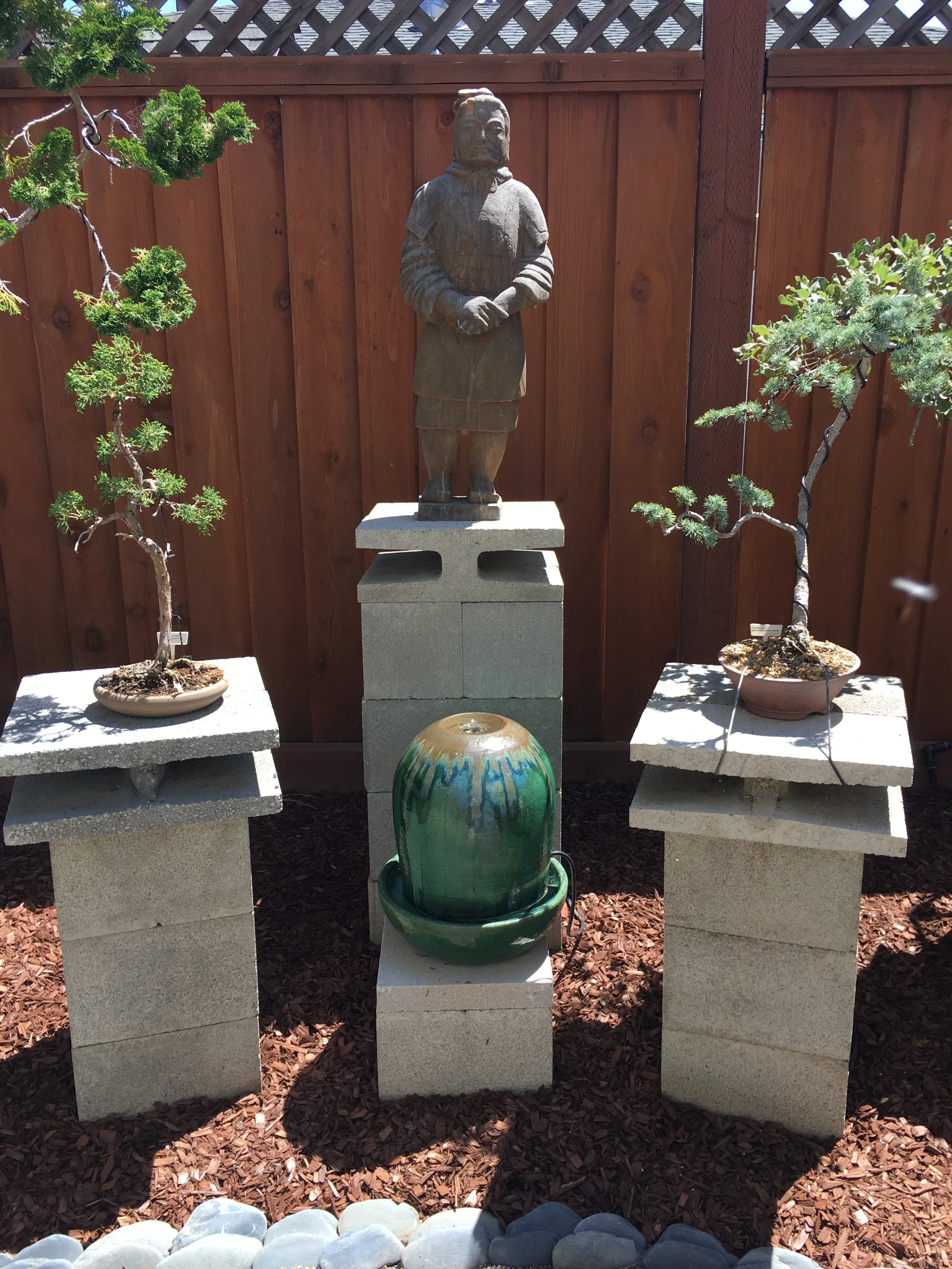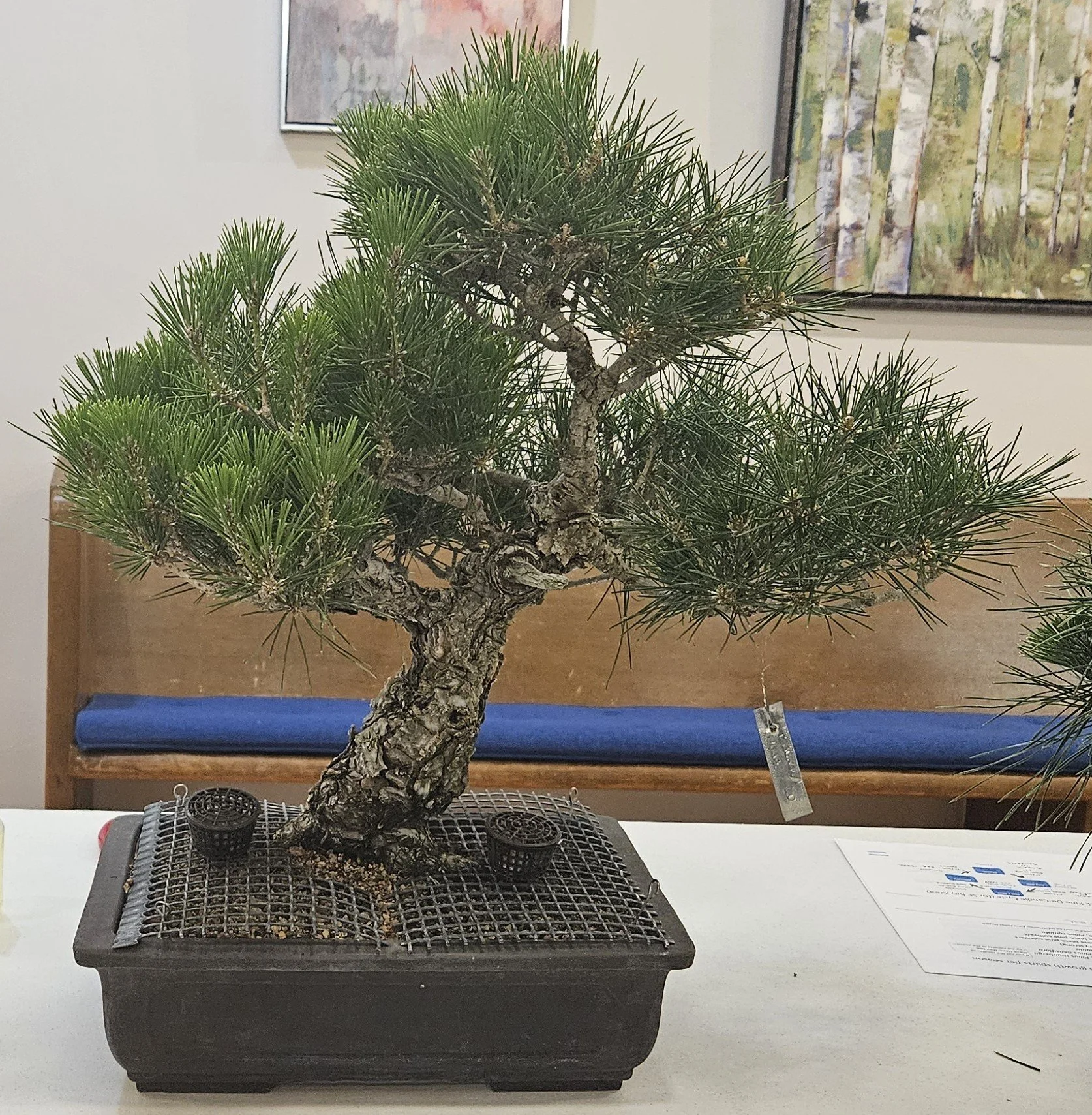July Club Meeting: Jonas Dupuich - Bonsai Design
by Lynne O’Dell
Although summer is not the time to be drastically pruning our bonsai, we’ve asked Jonas Dupuich to provide some guidelines and principles to keep in mind as we style and rework our trees later in the year. He will describe and show how pruning and styling can convey and suggest the “story” of your bonsai including its age, species, location and realism. His interactive participatory style will combine slides, trees and an exercise to convey his message.
In addition to our “Show and Tell” section of the meeting, Jonas encourages a few member trees in various stages of refinement to be brought in that he’ll use to demonstrate some of his design principals. Jonas will have his new book “The Essential Bonsai Book” for sale.
by Rita Curbow
Dates for Upcoming Workshops:
Saturday, July 26: Summer Care
Michael Greenstein will cover tips on dealing with pests, fertilizing, watering, protecting from sun/heat and wind.
Saturday, August 23: Wiring
This will be a repeat of our previous class on wiring but with additional info and improved exercises. The goal is to offer Wiring twice a year.
Saturday, September 27: Styling
This will be a repeat of the class offered earlier this year. The goal is to offer Styling twice a year
Schedule of Workshop:
12:30PM - 1:30PM “Intro to Bonsai”
For those new to bonsai or who want to brush up on basis bonsai techniques, special instruction will be offered starting at the beginning of the workshop and running for about an hour. After the special instruction/exercise, attendees will have the option to work on their trees with assistance from more advanced members until 4:30PM that day.
1:30PM - 4:30PM Open to all members of the club
Members at the intermediate or advanced levels who aren’t assisting other members in the beginner’s level are asked to arrive starting at 1:30pm. They will setup on the side closest to the main entrance (near the closet with tables).
Location of Workshop
Inside the Fellowship Hall at St Mark’s Episcopal Church, 600 Colorado Ave, Palo Alto
Refreshments at the Workshop
Feel free to bring refreshments to the workshop to share with fellow members. And don’t forget to bring bottled water for your personal use.
Details of the “Intro to Bonsai” Workshop Portion
Members should bring trees that can be worked on in that time of year. Club wire will be provided for beginners as needed. Some club tools will also be available, but members will be encouraged to purchase their own set of tools eventually in order to work on their trees at home, etc.
Setup and Cleanup at the Workshop
The club kindly thanks everyone who helped with setup and/or cleanup at the end. Your assistance makes a world of difference for the organizers of these events.
ABS “Intro to Bonsai” Syllabus
If you did not attend an “Intro to Bonsai” workshop in the past and have not received a free copy of the ABS Syllabus being used, please contact Michael Greenstein via email at michael.greenstein@comcast.com. Note that you must be a Kusamura member to participate in these workshops.
For those curious, ABS Syllabus refers to "Introduction to Bonsai: A Course Syllabus" by Thomas L. Zane of the American Bonsai Society.
Monthly Club Workshop Update
In Memory of Bill Daniels
by Lynne O’Dell
Kusamura member Bill Daniels passed away early June from a rare brain cancer. Over Bill’s lifetime horticultural pursuits have been a part of his life. Bill’s first foray into bonsai was inspired by Bob Kato who was part of the Belmont group that eventually formed Sei Boku Bonsai Kai (SBBK). When Annette and Bill were first married, they had a greenhouse in their living room filled with orchids.
Next, came his passion for fuchsias and then African violets where he filled his room with wall-to-wall shelves of various species. He even began writing a book about them, complete with meticulous hand drawn illustrations. After these pursuits, Annette recalls that Bill returned to the fascinating world of bonsai where friendships were made through various clubs and his artistic skills were acknowledged and honed by other astute leaders throughout the bonsai world.
Bill’s meticulous bonsai garden was a stop in our 2019 August Bonsai Garden Tour. As Bill’s health waned, both Bill and Annette continued to attend club meetings and shows. Annette is grateful for the friendship and support Bill received from both Kusamura and SBBK members over the years. It is her earnest desire to maintain a portion of his bonsai collection to continue to enjoy their beauty and to honor his memory.
June Meeting Recap – “Light the Fuse!” - Michael Greenstein on Many Kinds of Pines and Decandling
by Idris Anderson
Michael rented a van to bring 10 pines from his own collection to the meeting. Wow! Members also filled three long tables with their own pines. The plan was to talk about different kinds of pines, their different needs: how to grow, develop, maintain, and most importantly how to decandle (or NOT!) at this time of year. Here are the members who brought pines:
Michael: Ten pines, along with two of Charlene Fischer’s pines to illustrate his talk:
1. Western White Pine (~100y): larger needles, collected in 1946 from Albuquerque, NM
2. Japanese White Pine (John Planting, ~50y): short needles, 5 needles per sheath, grafted on black pine root stock
3. Lodgepole Pine (35 y): Phil Richardson demo tree; repotted, rewired
-Mugo Pine: Charlene
-Scots Pine: Charlene
4. Japanese Black Pine (75y): from John Planting; strong candles
5. Japanese Black Pine (30y): grown from seed / cutting; working on bulking up top
6. Japanese Black Pine (50y): from John Planting, too weak to candle prune
7. Japanese Black Pine (35y): Richard K; Bunjin, too early/weak to candle prune; 6” needles
8. Japanese Black Pine (50y): (medium) from seed / Lonnie; 50% candle pruned
9. Japanese Corkbark Black Pine (35y): John Planting dense budding
10. Japanese Corkbark Black Pine (35y): John Planting; root over rock; alternate candle pruning
Christine Weigen: Two Japanese Black Pines
Jenn Tan: Japanese Black pine, a Monterey Pine, and a Mugo Pine
Dave Curbow: Japanese Black Pine - in an Anderson flat, ready to transition from development to refinement phase.
Lynne O’Dell: Lodgepole Pine (which was raffled off)
Katherine Glassey: Monterey Pine
Ray Giron: Japanese "Mikawa" Black Pine.
Before the parade of pines brought by members—with Michael’s advice on each: whether to decandle or not and other advice—Michael reviewed for us the different kinds of pines used for bonsai and distinguished Black Pines and Red Pines that are double-flush from other kinds of pines that are single flush. Only double flush candles can be decandled in June or early July. Michael’s target date in this area is July 4, after which there is plenty of time for new candles to develop before cut back to two buds in October.
ONLY HEALTHY PINES SHOULD BE DECANDLED.
ONLY PINES THAT HAVE MOVED FROM DEVELOPMENT TO REFINEMENT STAGES SHOULD BE DECANDLED
The pine should have a trunk with the thickness desired before removing growth (candles) that contribute to primary structure. Let it GROW, healthy and strong, maybe for years before putting into refinement. Michael calls July 4 Lighting the Fuse Day, the day he targets for cutting candles on his pines. Candle cutting stimulates the development of buds, 2-5 usually but on really healthy trees in Japan, they get as many as 12 new buds!
So what’s the point of cutting candles? Three goals actually:
Energy balance (growth rate): pines are apically (top) dominant
Ramification (including back-budding): to fill out the tree and prevent long internodes
Needle reduction: reduce 6” needles to 2” or less
Cutting candles forces a second flush of needles. By varying the length of the candle cut, leaving two diameter widths for stronger candles, usually at the top of the tree; one diameter width for average candles at the middle of the tree, and little or no candle width for weaker, smaller candles near the bottom of the tree, we set the “fuse,” in Michael’s terms, for the development of new candles. Those left with a longer candle base take longer for stimulus to reach to base for bud development; those cut shorter, or very short, begin to develop sooner and stronger—hence, balancing the growth of the tree.
The information reviewed was extracted from a larger presentation on pines we had in 2020, and the full handout is saved on our website HERE. The exact slides reviewed in this meeting were 10, 17, 19-21, 26, 29, and 31.
Many thanks to Michael for this lively, thorough, clear presentation, and all his responsiveness to our questions.
Thank you to all who brought trees for this great program! It’s always wonderful to see trees from our members—in this case, all one species but with many different varieties. A great participatory event in anticipation for July 4, LIGHT THE FUSE Day!
Our June meeting is also the time when the new Board of Directors and Officers are sworn in and confirmed.
Here is our newest line-up from left to right: Ray Giron, Paticia Lee, Michael Greenstein, Charlene Fischer, Lynne O’Dell, Idris Anderson, Jenn Tan, Katherine Glassey, and Hal Jerman.
Recommended Blog Articles from Bonsai Tonight
We have as our guest artist this month, Bay Area bonsai professional Jonas Dupuich. Many of us in Kusamura know Jonas well. We have had him as a guest more than any other presenter. During the Covid lockdown, he saved us time and again by doing some of the first (maybe the first) Zoom meeting. And we’ve often called him in a pinch when another guest cannot make it at the last minute.
I suspect most of us subscribe to his bonsai blog Bonsai Tonight, highly recommended that you do this. He has done more than a thousand posts over the last 10 years and they are all archived and indexed--go-to place for when we have questions. I visit often. He is probably best known for his work with pines, but his experience and blogs cover the full range. He has become more and more interested in deciduous work, and he regularly reviews bonsai shows around the US and world.
I’ve selected just a few of his blogs below to check out, some now almost 10 years old, all fascinating. What strikes me again and again is how patient he is going through all the steps of development and design. He usually does not begin with a mature tree that just needs a quick demo styling. He patiently lets us follow the steps, season after season, year after year. I would venture to say that most of the trees he’s working on in his blogs are not yet in bonsai pots. His experience is a cautionary tale for those of us who want a finished, showable tree instantly or next year or two or three years from now. He’s the antidote for our impatience, a necessary reminder that the development of bonsai is a long-term commitment.
Creating redwood bonsai: reducing the sacrifice branch
August 23, 2023
https://bonsaitonight.com/2023/08/25/creating-redwood-bonsai-reducing-the-sacrifice-branch/
How to determine direction or flow of a bonsai
December 10, 2021
https://bonsaitonight.com/2021/12/10/how-to-determine-the-direction-or-flow-of-a-bonsai/
Sierra juniper first steps
December 17, 2020
https://bonsaitonight.com/2020/11/17/sierra-juniper-first-steps/
Watching bonsai become bonsai
July 12, 2016
https://bonsaitonight.com/2016/07/12/watching-bonsai-become-bonsai/
by Idris Anderson
Club members Aida and Robert Li recently visited the Meiji Shrine in Shibuya, Tokyo and enjoyed a display of bonsai and suiseki.
This 'Nejikan' is a dramatic example of the characteristic twisted pomegranate growth.
The exhibition is sponsored by the Nippon Suiseki Association which was established in 1961. The president of the association is always a head priest selected from Meiji Shrine.
Monthly Tasks
Each month there are a number of tasks you need to do to your bonsai – from repotting, to fertilizing to spraying for pests. We have put together a checklist, customized for the San Francisco Bay Area to help you. This checklist is adapted from earlier work by Mitsuo Umehara.
This month: July Tasks








